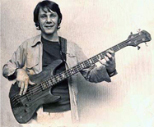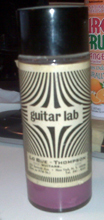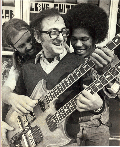 |
| Early Carl Thompson Bass |
The Guitar Lab was formed in a room over Eddie Bells Music on West 49th Street in 1969. Charles LoBue and Carl Thompson opened their own shop right down the hall from Dan Armstrong doing repairs and setups with one of their primary customers being Eddie Bells Music owned by Mark Biddleman. In 1971 LoBue and Thompson moved to 701 7th Avenue. Steve Blucher who did mostly wiring and setup worked there at the time. Thompson and LoBue maintained this shop until 1973 when Thompson went off on his own.According to Thompson, LoBue had wanted to build guitars and Thompson wanted to stick with repairs so they parted and Blucher followed.. LoBue shortly thereafter moved to 206 Thompson. Within a year or around 1970 the Guitar Lab moved to 701 7th Avenue with an emphasis remaining on repairs. Tyler Blick showed an example of Guitar Lab strings package on page 97 of her book entitled “Trademarks of the ‘60’s and 70’s”.
 |
| LoBue-Thompson Guitars Inc. Guitar Strings |
The Guitar Lab was a guitar repair and customizing shop with two talented technical geniuses working together. About this time Bob Sindorf, a student at Columbia University, was coming in on weekends and between classes. Sindorf had started to make guitars in his bedroom as a kid and was looking for a part to complete a guitar that he was building in his dorm. Sindorf continued to work with LoBue through 1976 when he began grad school. At this time the work crew included Sindorf who was a master carver, Woody Phifer who was a master carver and did beautiful fretwork, Larry DiMarzio who did fretwork and electronics, Dave Hill who did wiring, Bruce Hoheb who was a great bass designer, Steve Boem, a touring musician who worked doing setups when in town.
Larry Di Marzio went to work for Charlie a week after he and Thompson separated, and worked at the 47th Street location for about a year. Bluucher
was already working with them. He stayed with Thompson and Di Marzio started with
LoBue. DiMarzio commented that he was paid $10.00 per day. " I was originally referred by Jack
Wilkens, my guitar teacher. Steve returned to Charlie again after the
Thompson Street location opened.
 |
| Guitar Polish |
Most of the work at the Guitar Lab was just repairs: lots of re-
strings, setups, and grind and polishes. Most of the work came from
studio players or 48th Street referrals. Charlie was never a rock
fan, so I did most of the light-gauge guitar setups. I learned my
basic fret work from Charlie, and eventually I visited Jimmy
D'Aquisto to get the master's tricks on polishing and fret finishing.
Eventually I showed Woody the ropes; he started before I left.
" Charlie's contribution to DiMarzio was interesting. One day he
asked me if I was any good with electronics. I said, "Yes, I went to
Brooklyn Tech as an electronics major and was in college doing an
engineering program." Charlie said, "There is a box of broken pickups
under the work bench. Why don't take them home and see if you can fix
them?" So I took the box home and the rest is history.
The original guitar pickups in Charlie's guitars were either
Gibsons or Guilds until Steve talked Charlie into putting my rebuilt
humbuckers into the LoBue guitars. Charlie would supply me with
Gibson parts and I would rebuild them at my home in Staten Island. No
DiMarzio pickups were ever built at either of Charlie's shops.
I never built any of the LoBue guitars myself, but Steve probably
did and installed a bunch of my pickups in them. At that point, I had
my own repair shop in Staten Island and I was playing, teaching, or
building pickups. I know that by 1974 DiMarzios were in Rick
Derringer's LoBue. "
Dave Hill was 19 when he first happened to wander into Charles' shop. Dave was shopping for a part on 48th street and someone suggested I go around the block to 701. From Hill's recollection, Charles was so unlike the 'get-outta-here-kid, yer-bothering-me' attitude on 48th street. They talked for a while about guitar projects Hill was doing at home and planned to do. He asked Hill if he'd like to work with him.
Hill indicated that working at Guitar Lab was, in retrospect, probably the best job he's ever had. It certainly wasn't the most lucrative but at that point money wasn't as important to him. Hill said he never recalled dreading coming to work - every day was a new adventure, "and we were making some pretty cool things. Every night I would come home with nostrils packed with mahogany and lacquer dust. (OSHA.what's OSHA??)"
Charles was a patient and kind man, even when under pressure. One time IHill was doing some mod on a sunburst ES-335 and neglected to protect the guitar body. The soldering iron slipped and sizzled away a spot of lacquer, of course in the space between the bridge and the f-hole. If there was a neon sign there, it wouldn't draw more attention. "I felt like throwing up." When Hill showed Charles, he was visibly upset but didn't yell, didn't scream, didn't fire him. He said 'let's see if we can fix this' and started to rub cigarette ash over the mark. Not very effective at hiding the blemish, but it broke the tension.
Hill said one of the things that made the Lab such a cool place to work was that it was amazingly democratic. Charles didn't fawn over stars and they leaned over the same dusty display cases that everyone else did. Hill remembers when Janis Ian came in to try hers for the first time. Humble Pie used to visit when they were in town, and Steve Marriot was one of the most down-to-earth guys you'd ever meet. Will Lee came in just after he joined the band 'Dreams' and released their first album.
And then there was when Charles would give each guitar its run-through. He had this little jazz riff that he would play EVERY SINGLE TIME and then he'd sing 'you're the cream in my coffee'. We'd all look at each other; Bob "Sindorf" would roll his eyes.
Hill left before the move to Thompson Street. He visited the Thompson Street shop a few times. One time, Hill saw Ralph Novak in the shop for the first time. Novak and Hill were in the same 7th grade class... before he had the handlebars. Another time, there was a 50's Epiphone Cortez that had a broken headstock; Charles let Hill have it for $15.
A few years later Hill got married and moved to an apartment on Bay Ridge Avenue in Bensonhurst, Brooklyn. They were there for a few years and one day he and his wife were crossing the street when he heard 'is that Dave Hill?'. There stood Charles with his young family. It turned out his mother lived across the street from them!
 |
Bob Sindorf, Charles LoBue, Woody Phifer |
Steve Kaufman who owned Hawk Electronics would drop by ofter with some sort of electronic gadget for experimentation in these guitars.This shop serviced all of the local music stores in the area.Richard Friedman whos’ parents started “We Buy Guitars” at 48th street between 6th and 7th remembers running over to LoBue’s shop on a regular basis to deliver an instrument for repair or to pick up a necessary part. Michael Gurian indicated that LoBue would purchase wood for his guitars from Gurians shop at 66 Carmine. Gurian was a luthier specializing primarily in acoustic and electro acoustic guitars. Sindorf, who has dedicated his life to sculpture for 30 years, enjoys making a few select guitars annually. You can see Sindorfs work as a sculptor here or enjoy some of his newer designs in guitars here. |